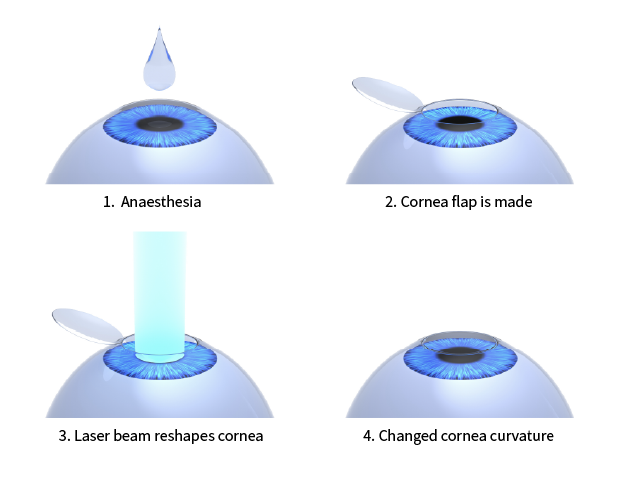
LASIK is shorthand for Laser In-situ Keratomileusis. This is arguably the most well-known laser eye surgery today, often used to treat refractive errors.
This procedure changes the shape of the cornea to correct the way light enters the eye and is focused onto the retina. This may allow patients to do away with prescription glasses or contact lenses.
LASIK is typically used to correct long-sightedness, short-sightedness, and astigmatism. These conditions are caused by distortions in the cornea’s shape.
Because LASIK can change the shape of the cornea, it can address the source of the problem in each of these problems.
To determine your suitability for LASIK, it’s best to see a doctor for a consultation. In general, people who are suitable for LASIK meet the following requirements:
Stable vision or spectacle power
Low risk of participating in contact sports
No evidence of keratoconus in the eye
Not pregnant or breastfeeding
Not afflicted with dry eyes
LASIK takes around 25 minutes in total for both eyes. Improved vision can often be noticed within the same day of the surgery.
The procedure itself is painless and follows these steps:
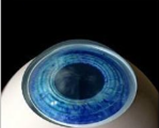
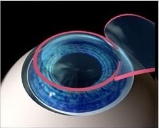
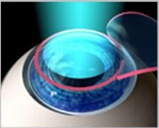
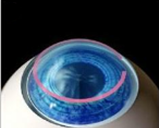
Most people see vision improvements within the first 24 to 48 hours of LASIK. Full recovery itself may take anywhere from a few weeks to a few months.
Your vision typically stabilises over time after LASIK surgery. This is why your doctor will schedule several check-ups to ensure all is progressing as expected.
LASIK is a refractive surgery that can treat issues like hyperopia, myopia, and astigmatism. It is generally indicated for cases where patients have normal but distorted (excepting conical) corneal shapes affecting their vision.
It is a short and largely painless procedure with minimal downtime and relatively fast recovery time. It is suitable for people with stable vision and lifestyles that have very low risk of causing eye trauma.
PRK is a procedure that removes the surface layer of the cornea before the LASIK procedure itself. This results in a gentler procedure that causes less trauma to the surrounding tissue.
This procedure is often recommended for those who prefer a treatment that requires no corneal flap and minimises inflammation risk. It is often performed on those whose lifestyles make eye trauma a regular risk.
TransPRK is the “no-touch” version of the PRK procedure, meaning it removes the outer layer of the cornea with the same laser correcting the patient’s refractive error. This turns it into a one-step procedure.
TransPRK can result in faster healing than traditional PRK. It is generally advised for people whose corneas make them unsuitable for LASIK or whose lifestyles carry a high risk of eye trauma. However, patients with keratoconus or cone-shaped corneas are not advised to get PRK.
ICL stands for an implantable collamer lens used to correct issues like myopia, hyperopia, and astigmatism. The surgery to implant this corrective soft lens involves creating a small corneal incision. Through this, the doctor inserts the lens in front of the patient’s natural lens and behind the iris.
The advantage of getting ICL surgery instead of LASIK is that ICL is reversible. It is a speedy surgery too that takes 10 to 20 minutes, with recovery often happening overnight. The treatment is often suggested to those with high myopia or a condition that makes LASIK or PRK inadvisable, such as weak corneas.
SMILE is a flapless laser vision correction procedure that uses a femtosecond laser to address refractive errors. This flapless approach may lower the risk of flap-related complications and is often associated with less dryness in the early stages of recovery compared to LASIK.
That said, SMILE may not be suitable for all patients. A thorough evaluation by an eye surgeon is essential to determine if this procedure is the right option for your visual needs and eye health.
The AMARIS laser is known for its speed and precision. This is an excimer laser system very often used for refractive and corneal treatments.
The AMARIS can correct a diopter of myopia in just 1.5 seconds. This makes it2 to 3 times faster than other laser systems.
The Schwind AMARIS laser is equipped with technology capable of tracking your eye’s position dynamically, with around1050 measurements per second. This allows it to compensate for deviations upto the sixth dimension.
You will be advised on the following when you come in for your pre-LASIK assessment for suitability and before the actual day of LASIK surgery. Please note that the pre-LASIK assessment will take around 2 to 2.5 hours.
Adequate rest is required after surgery for smooth recovery. Rest at home after surgery, observe good hygiene and adhere to the following.
For one week:
With advancing technology and sophisticated surgical skills today, the safety and effectiveness of LASIK surgery continues to improve.
Laser eye surgery has successfully treated millions of patients and has high patient satisfaction rates. However, as with any surgery, it has potential complications. It is important for you to weigh the benefits and risks before choosing to go ahead with surgery.